Xiaolong Jin
An Investigation on Group Query Hallucination Attacks
Aug 26, 2025Abstract:With the widespread use of large language models (LLMs), understanding their potential failure modes during user interactions is essential. In practice, users often pose multiple questions in a single conversation with LLMs. Therefore, in this study, we propose Group Query Attack, a technique that simulates this scenario by presenting groups of queries to LLMs simultaneously. We investigate how the accumulated context from consecutive prompts influences the outputs of LLMs. Specifically, we observe that Group Query Attack significantly degrades the performance of models fine-tuned on specific tasks. Moreover, we demonstrate that Group Query Attack induces a risk of triggering potential backdoors of LLMs. Besides, Group Query Attack is also effective in tasks involving reasoning, such as mathematical reasoning and code generation for pre-trained and aligned models.
ASTRA: Autonomous Spatial-Temporal Red-teaming for AI Software Assistants
Aug 05, 2025Abstract:AI coding assistants like GitHub Copilot are rapidly transforming software development, but their safety remains deeply uncertain-especially in high-stakes domains like cybersecurity. Current red-teaming tools often rely on fixed benchmarks or unrealistic prompts, missing many real-world vulnerabilities. We present ASTRA, an automated agent system designed to systematically uncover safety flaws in AI-driven code generation and security guidance systems. ASTRA works in three stages: (1) it builds structured domain-specific knowledge graphs that model complex software tasks and known weaknesses; (2) it performs online vulnerability exploration of each target model by adaptively probing both its input space, i.e., the spatial exploration, and its reasoning processes, i.e., the temporal exploration, guided by the knowledge graphs; and (3) it generates high-quality violation-inducing cases to improve model alignment. Unlike prior methods, ASTRA focuses on realistic inputs-requests that developers might actually ask-and uses both offline abstraction guided domain modeling and online domain knowledge graph adaptation to surface corner-case vulnerabilities. Across two major evaluation domains, ASTRA finds 11-66% more issues than existing techniques and produces test cases that lead to 17% more effective alignment training, showing its practical value for building safer AI systems.
A Survey of Link Prediction in N-ary Knowledge Graphs
Jun 10, 2025



Abstract:N-ary Knowledge Graphs (NKGs) are a specialized type of knowledge graph designed to efficiently represent complex real-world facts. Unlike traditional knowledge graphs, where a fact typically involves two entities, NKGs can capture n-ary facts containing more than two entities. Link prediction in NKGs aims to predict missing elements within these n-ary facts, which is essential for completing NKGs and improving the performance of downstream applications. This task has recently gained significant attention. In this paper, we present the first comprehensive survey of link prediction in NKGs, providing an overview of the field, systematically categorizing existing methods, and analyzing their performance and application scenarios. We also outline promising directions for future research.
KnowCoder-V2: Deep Knowledge Analysis
Jun 07, 2025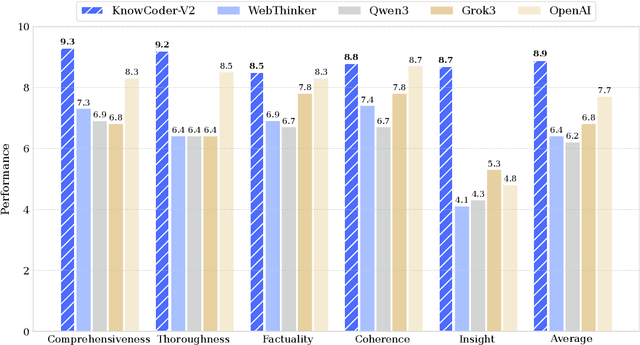
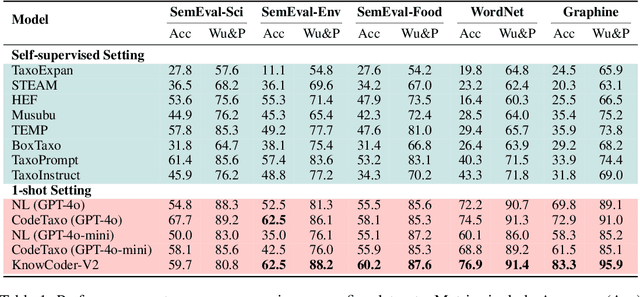
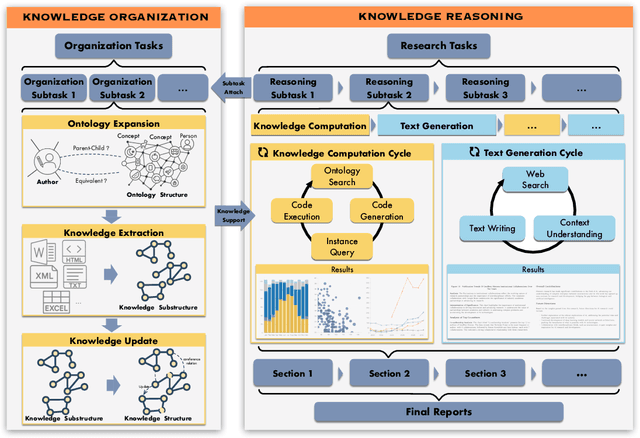

Abstract:Deep knowledge analysis tasks always involve the systematic extraction and association of knowledge from large volumes of data, followed by logical reasoning to discover insights. However, to solve such complex tasks, existing deep research frameworks face three major challenges: 1) They lack systematic organization and management of knowledge; 2) They operate purely online, making it inefficient for tasks that rely on shared and large-scale knowledge; 3) They cannot perform complex knowledge computation, limiting their abilities to produce insightful analytical results. Motivated by these, in this paper, we propose a \textbf{K}nowledgeable \textbf{D}eep \textbf{R}esearch (\textbf{KDR}) framework that empowers deep research with deep knowledge analysis capability. Specifically, it introduces an independent knowledge organization phase to preprocess large-scale, domain-relevant data into systematic knowledge offline. Based on this knowledge, it extends deep research with an additional kind of reasoning steps that perform complex knowledge computation in an online manner. To enhance the abilities of LLMs to solve knowledge analysis tasks in the above framework, we further introduce \textbf{\KCII}, an LLM that bridges knowledge organization and reasoning via unified code generation. For knowledge organization, it generates instantiation code for predefined classes, transforming data into knowledge objects. For knowledge computation, it generates analysis code and executes on the above knowledge objects to obtain deep analysis results. Experimental results on more than thirty datasets across six knowledge analysis tasks demonstrate the effectiveness of \KCII. Moreover, when integrated into the KDR framework, \KCII can generate high-quality reports with insightful analytical results compared to the mainstream deep research framework.
Mixture Policy based Multi-Hop Reasoning over N-tuple Temporal Knowledge Graphs
May 19, 2025Abstract:Temporal Knowledge Graphs (TKGs), which utilize quadruples in the form of (subject, predicate, object, timestamp) to describe temporal facts, have attracted extensive attention. N-tuple TKGs (N-TKGs) further extend traditional TKGs by utilizing n-tuples to incorporate auxiliary elements alongside core elements (i.e., subject, predicate, and object) of facts, so as to represent them in a more fine-grained manner. Reasoning over N-TKGs aims to predict potential future facts based on historical ones. However, existing N-TKG reasoning methods often lack explainability due to their black-box nature. Therefore, we introduce a new Reinforcement Learning-based method, named MT-Path, which leverages the temporal information to traverse historical n-tuples and construct a temporal reasoning path. Specifically, in order to integrate the information encapsulated within n-tuples, i.e., the entity-irrelevant information within the predicate, the information about core elements, and the complete information about the entire n-tuples, MT-Path utilizes a mixture policy-driven action selector, which bases on three low-level policies, namely, the predicate-focused policy, the core-element-focused policy and the whole-fact-focused policy. Further, MT-Path utilizes an auxiliary element-aware GCN to capture the rich semantic dependencies among facts, thereby enabling the agent to gain a deep understanding of each n-tuple. Experimental results demonstrate the effectiveness and the explainability of MT-Path.
SkillWeaver: Web Agents can Self-Improve by Discovering and Honing Skills
Apr 09, 2025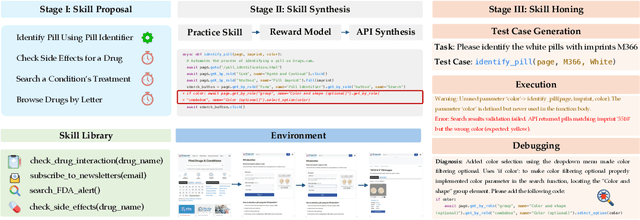
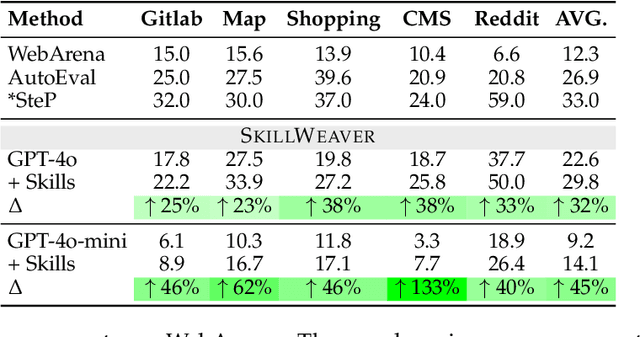
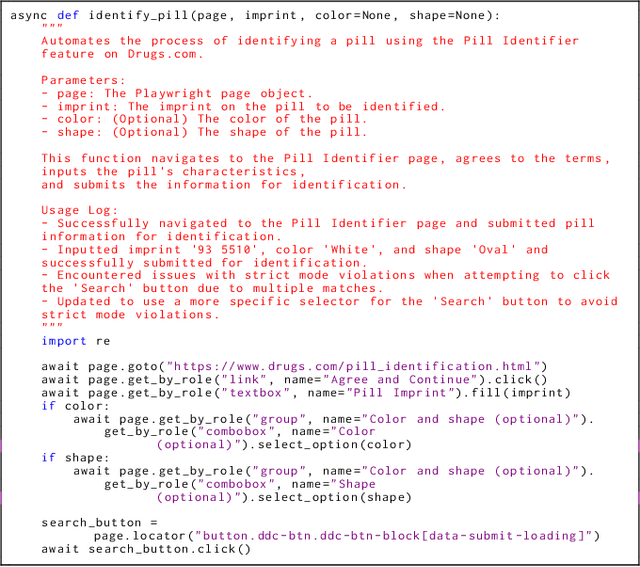

Abstract:To survive and thrive in complex environments, humans have evolved sophisticated self-improvement mechanisms through environment exploration, hierarchical abstraction of experiences into reuseable skills, and collaborative construction of an ever-growing skill repertoire. Despite recent advancements, autonomous web agents still lack crucial self-improvement capabilities, struggling with procedural knowledge abstraction, refining skills, and skill composition. In this work, we introduce SkillWeaver, a skill-centric framework enabling agents to self-improve by autonomously synthesizing reusable skills as APIs. Given a new website, the agent autonomously discovers skills, executes them for practice, and distills practice experiences into robust APIs. Iterative exploration continually expands a library of lightweight, plug-and-play APIs, significantly enhancing the agent's capabilities. Experiments on WebArena and real-world websites demonstrate the efficacy of SkillWeaver, achieving relative success rate improvements of 31.8% and 39.8%, respectively. Additionally, APIs synthesized by strong agents substantially enhance weaker agents through transferable skills, yielding improvements of up to 54.3% on WebArena. These results demonstrate the effectiveness of honing diverse website interactions into APIs, which can be seamlessly shared among various web agents.
Towards Robust Universal Information Extraction: Benchmark, Evaluation, and Solution
Mar 05, 2025Abstract:In this paper, we aim to enhance the robustness of Universal Information Extraction (UIE) by introducing a new benchmark dataset, a comprehensive evaluation, and a feasible solution. Existing robust benchmark datasets have two key limitations: 1) They generate only a limited range of perturbations for a single Information Extraction (IE) task, which fails to evaluate the robustness of UIE models effectively; 2) They rely on small models or handcrafted rules to generate perturbations, often resulting in unnatural adversarial examples. Considering the powerful generation capabilities of Large Language Models (LLMs), we introduce a new benchmark dataset for Robust UIE, called RUIE-Bench, which utilizes LLMs to generate more diverse and realistic perturbations across different IE tasks. Based on this dataset, we comprehensively evaluate existing UIE models and reveal that both LLM-based models and other models suffer from significant performance drops. To improve robustness and reduce training costs, we propose a data-augmentation solution that dynamically selects hard samples for iterative training based on the model's inference loss. Experimental results show that training with only \textbf{15\%} of the data leads to an average \textbf{7.5\%} relative performance improvement across three IE tasks.
Towards Event Extraction with Massive Types: LLM-based Collaborative Annotation and Partitioning Extraction
Mar 04, 2025Abstract:Developing a general-purpose extraction system that can extract events with massive types is a long-standing target in Event Extraction (EE). In doing so, the challenge comes from two aspects: 1) The absence of an efficient and effective annotation method. 2) The absence of a powerful extraction method can handle massive types. For the first challenge, we propose a collaborative annotation method based on Large Language Models (LLMs). Through collaboration among multiple LLMs, it first refines annotations of trigger words from distant supervision and then carries out argument annotation. Next, a voting phase consolidates the annotation preferences across different LLMs. Finally, we create the EEMT dataset, the largest EE dataset to date, featuring over 200,000 samples, 3,465 event types, and 6,297 role types. For the second challenge, we propose an LLM-based Partitioning EE method called LLM-PEE. To overcome the limited context length of LLMs, LLM-PEE first recalls candidate event types and then splits them into multiple partitions for LLMs to extract events. The results in the supervised setting show that LLM-PEE outperforms the state-of-the-art methods by 5.4 in event detection and 6.1 in argument extraction. In the zero-shot setting, LLM-PEE achieves up to 12.9 improvement compared to mainstream LLMs, demonstrating its strong generalization capabilities.
Foot-In-The-Door: A Multi-turn Jailbreak for LLMs
Feb 28, 2025Abstract:Ensuring AI safety is crucial as large language models become increasingly integrated into real-world applications. A key challenge is jailbreak, where adversarial prompts bypass built-in safeguards to elicit harmful disallowed outputs. Inspired by psychological foot-in-the-door principles, we introduce FITD,a novel multi-turn jailbreak method that leverages the phenomenon where minor initial commitments lower resistance to more significant or more unethical transgressions. Our approach progressively escalates the malicious intent of user queries through intermediate bridge prompts and aligns the model's response by itself to induce toxic responses. Extensive experimental results on two jailbreak benchmarks demonstrate that FITD achieves an average attack success rate of 94% across seven widely used models, outperforming existing state-of-the-art methods. Additionally, we provide an in-depth analysis of LLM self-corruption, highlighting vulnerabilities in current alignment strategies and emphasizing the risks inherent in multi-turn interactions. The code is available at https://github.com/Jinxiaolong1129/Foot-in-the-door-Jailbreak.
SuperGPQA: Scaling LLM Evaluation across 285 Graduate Disciplines
Feb 20, 2025Abstract:Large language models (LLMs) have demonstrated remarkable proficiency in mainstream academic disciplines such as mathematics, physics, and computer science. However, human knowledge encompasses over 200 specialized disciplines, far exceeding the scope of existing benchmarks. The capabilities of LLMs in many of these specialized fields-particularly in light industry, agriculture, and service-oriented disciplines-remain inadequately evaluated. To address this gap, we present SuperGPQA, a comprehensive benchmark that evaluates graduate-level knowledge and reasoning capabilities across 285 disciplines. Our benchmark employs a novel Human-LLM collaborative filtering mechanism to eliminate trivial or ambiguous questions through iterative refinement based on both LLM responses and expert feedback. Our experimental results reveal significant room for improvement in the performance of current state-of-the-art LLMs across diverse knowledge domains (e.g., the reasoning-focused model DeepSeek-R1 achieved the highest accuracy of 61.82% on SuperGPQA), highlighting the considerable gap between current model capabilities and artificial general intelligence. Additionally, we present comprehensive insights from our management of a large-scale annotation process, involving over 80 expert annotators and an interactive Human-LLM collaborative system, offering valuable methodological guidance for future research initiatives of comparable scope.
 Add to Chrome
Add to Chrome Add to Firefox
Add to Firefox Add to Edge
Add to Edge